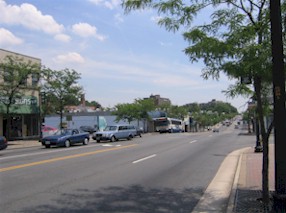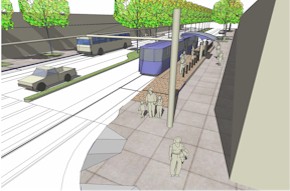|
Street
Cars and Zoning Codes
Arlington
County is trying novel tools to revitalize Columbia Pike, an aging traffic corridor.
By
Bob Burke
ARLINGTON
COUNTY – It’s 7 a.m. on an hot August morning
and the height of rush hour in this Washington,
D.C., suburb. But it sure doesn’t look like it
here on Columbia Pike.
Nearby
Interstates 66 and 95 are jammed with cars. But
this street has modest commuter traffic. Much of
it is headed to the nearby Pentagon or the
Army’s Fort Myer post, or toward the 14th Street
bridge into the city.
The
drivers who use this route may think it’s
overlooked by everyone else – and in a way
they’d be right. Despite a location close to the
city in the heart of one of the country’s
wealthiest metropolitan areas, Columbia Pike has
turned to seed. A few decades ago, the
thoroughfare played a bigger role in moving
traffic, earning the nickname “Arlington’s
Main Street.” But the interstates and the
region’s Metrorail subway system carry commuters
now. The pike is left with an unworkable mix of
auto-oriented development: strip-mall shopping
centers with their oversized parking lots next to
mom-and-pop businesses and apartment buildings.
Developers and gentrifiers have looked elsewhere
for opportunity.

Contrast
that with the scene a few miles north on
Arlington’s Wilson Boulevard, where the
Metrorail system has spurred a huge economic
revival, with major commercial and residential
projects rising above underground commuter rail
stops. On the pike the only new commercial
developments during a recent 10-year period were a
bank and a drug store, says Chris Zimmerman, a
member of the county’s Board of Supervisors.
“That was it,” he says. “So, stuff wasn’t
really happening.”
Arlington
leaders have adopted a two-pronged strategy to
re-engineer Columbia Pike. They’re combining a
cutting-edge zoning code to revive growth and
investment, and bringing back an old transit tool
– the streetcar – to move more people. If the
approach succeeds, Columbia Pike will showcase how
the right streetscape design and transportation
mix can spur renewal in aging suburbs rather than
flinging growth into the countryside.
The
new zoning tool is the “form-based code,” and
only a handful of other localities in the country
have used it. Arlington’s version, which is
voluntary, was adopted in early 2003 after
hundreds of public discussions and meetings with
community residents. Applying to four specific
districts on the pike, the code calls for creating
mixed-use development districts, street-front
buildings with ground-floor retail and parking
either underneath or behind the buildings. Unlike
traditional zoning, which aims to separate land
uses, a form-based code defines the scale and
appearance of development - such as the height and
placement of buildings, and the use of windows and
building materials.
Proponents
of New Urbanism consider form-based codes an
expression of their vision of a more urban,
pedestrian-friendly, mixed-use development.
Technically, a form-based code is neutral – it
can define whatever the community wants. But when
residents get to pick the kind of streetscape they
prefer, “more often than not they choose higher
density, urban-style format,” says Jason
Burdette, a planner who has done extensive study
on the Columbia Pike initiative.
What’s
more, unlike the more traditional site-plan
approach, in which the developer largely controls
a project’s design and appearance, form-based
codes allow residents to get involved beforehand
in defining what they want. The pike has an
ethnically diverse mix of middle- and low-income
apartment-dwellers who depend on public transit
and sidewalks. “I see the form-based codes as
sort of an empowering tool for them, to see that
they can participate in the process,” Burdette
says.
Another
advantage of form-based codes for older, developed
areas with multiple property owners is that they
allow the community’s vision to develop over time.
There’s no need for a big developer to come in
and assemble a large piece of property. “We had
existing owners and therefore existing property
rights,” Zimmerman says.
Supporters
of the new code cite a surge in new projects.
Since the code was adopted in February 2003,
according to the county, nearly $500 million in
new development that follows the form-based code
have been approved or are in the approval process.
The
county’s effort has its skeptics. David DeCamp,
a senior vice president with the Washington office
of the real estate firm Grubb & Ellis, notes
that some in the private sector criticized the
codes for forcing what he calls “too much ‘Big
Brother’ control” on the developer. “At
first there was some negativity out there,"
he says, "because they thought it was overly
prescriptive.”
Apprehension
is easing, says DeCamp, who is president of the
Columbia Pike Revitalization Organization, a
nonprofit group formed in 1986 and funded in part
by the county. Form-based codes offer developers
some benefits. “The real advantages are the
ability to walk into a redevelopment and have a
fairly predictable outcome,” he says. Projects
under 40,000 square feet can be reviewed in under
30 days, with no public hearings. Bigger projects
can expect an approval process of 30 to 60 days.
There
have been some problems, though, DeCamp
acknowledges. He’s working on a 75-unit
residential development and there’s some
uncertainty about exactly how to apply the new
rules. “We’ve got this code out there but we
have not yet nailed down where all the streets
are,” he says. “If you don’t know where the
streets are, you don’t know where the required
building line is.” DeCamp considers these
problems just wrinkles to be worked out. “There
are naysayers out there that think this is a bad
way to go,” he says. “But we’re going to
look back in three or four years and say Columbia
Pike is a better place.”
The
second element in Columbia Pike's renaissance will
be a new streetcar system -- potentially the first
new system in Virginia -- which DeCamp and others
say could knit together the new development of the
pike.
The
Washington Metropolitan Area Transit Authority,
which has finished a year-long study of the
corridor, is recommending a combination of
streetcars and buses alternating in the right lane
along most of the corridor. The center lane would
be reserved for vehicle traffic, and there’d be
room in the median for left-turn lanes. The pike
already has a thriving bus line that carries about
12,000 riders daily, says Zimmerman, and adding
streetcars could double the capacity, improving
mobility in the corridor. “You can put a serious
dent in (the number of) cars, and you can change
the lifestyle,” he says.

The
streetcar system would cost an estimated $120
million. Planners also considered a bus rapid
transit system, but projections showed it would
carry fewer riders. Plus, it had less public
support, particularly from businesses along the
pike. “The business community in this corridor
has said [it] would be much more likely to invest
in a streetcar than in bus,” says Robin
McElhenny, project director for the pike transit
study. “We don’t have a lot of case studies
that show BRT stimulating economic development.”
DeCamp
cites the experience of Portland, Ore, which added
streetcar service in its downtown four years ago.
The system “really fostered development of all
sorts in seedy down-and-out parts of Portland,”
says DeCamp, who toured the Portland project last
fall. He thinks the potential economic impact
gives property owners a reason to help pay for it,
possibly through creation of a tax district. “I
think that’s how these things get funded. The
local landowners… have got to say, ‘We want
this and we’re willing to chip in.’”
McElhenny
says the new report briefly considers a few
funding options but the issue needs more study.
Right now supporters are glad to see new projects
coming to the pike and are hopeful they can
complete the vision. Planners are working with
neighboring Fairfax County, which would have one
end of the proposed streetcar line. Fairfax
leaders also decided last month to consider
adopting their own form-based code for parts of
the county. But changing Columbia Pike will take
time, Zimmerman says. “It’s not going to
happen overnight.” New, higher-density
development will fill in underused land and a more
urban streetscape will emerge, he predicts.
“There’s great potential here.”
Bacon's
Rebellion News Service
August
8, 2005
|
